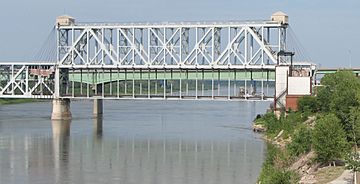ASB Bridge facts for kids
Quick facts for kids ASB Bridge |
|
|---|---|

ASB Bridge from Westport Landing, span in lowered position, in 2006
|
|
| Coordinates | 39°06′59″N 94°34′47″W / 39.116527°N 94.57974°W |
| Carries |
|
| Crosses | Missouri River |
| Locale | Kansas City, Missouri, and North Kansas City, Missouri |
| Official name | Armour-Swift-Burlington Bridge |
| Other name(s) | Winner bridge, Fratt Bridge |
| Named for | Armour-Swift-Burlington |
| Maintained by | BNSF Railway |
| Preceded by | Second Hannibal Bridge |
| Followed by | Heart of America Bridge |
| Characteristics | |
| Design | Double-deck truss bridge with vertical lift |
| Total length | 1,282 ft (391 m) |
| Longest span | 428 ft (130 m) |
| History | |
| Designer | Waddell & Harrington |
| Opened | 1911 |
The Armour-Swift-Burlington (ASB) Bridge is a special bridge that crosses the Missouri River in Kansas City, Missouri. It used to carry both cars and trains, but now it's mainly used for trains. People also know it as the North Kansas City Bridge or the LRC Bridge.
Contents
A Look Back at the ASB Bridge
The first parts of the bridge, called piers, were built in 1890. But there wasn't enough money to finish the bridge back then. So, the project stopped.
In 1909, a famous engineering firm called Waddell & Harrington designed the bridge we see today. Construction began soon after. This bridge is one of only two bridges of its kind. It was designed with two levels. The top level carried cars on Route 9, and the bottom level carried trains.
What made this bridge really cool was its "vertical lift" design. The lower part of the bridge could be lifted straight up. This allowed big riverboats to pass underneath without stopping car traffic on the top level. The design was clever because the parts that held the lower deck could go through the main supports of the upper deck.
Three companies worked together to build this bridge: Armour Packing Company, Swift & Company, and Chicago, Burlington and Quincy Railroad.
In 1987, a new bridge called the Heart of America Bridge opened nearby. This new bridge took over the car traffic. So, the ASB Bridge no longer needed its upper deck for cars.
In 1996, the ASB Bridge was recognized as a National Historic Civil Engineering Landmark by the American Society of Civil Engineers. This means it's a very important and historic engineering achievement. Today, the BNSF Railway owns and maintains the bridge. The main part of the ASB Bridge that lifts up is about 428 feet long. This makes it the ninth-longest vertical-lift drawbridge in the United States.
Important Dates for the ASB Bridge
Here's a timeline of key events for the ASB Bridge:
Early Years and Opening
- 1890: Nine stone piers were built for a bridge. However, the engineer, John Alexander Low Waddell, disagreed with the pier design. Funding stopped, and the piers sat unused for many years.
- 1909: The Armour Packing House, Swift and Company, and Chicago Burlington and Quincy Railroad companies provided money to build the bridge.
- The old piers were made shorter. J. A. L. Waddell's company, Waddell & Harrington, created a new design, and construction began.
- December 28, 1911: The bridge officially opened to traffic. It had two lanes for cars on the upper level and one track for trains on the lower level.
- January 1913: Electric streetcars started using the rails on the upper deck.
- 1915 to 1926: The bridge was part of the Jefferson Highway, an important road at the time.
Changes and Repairs
- May 2, 1927: A fire damaged the south approach span (the part leading up to the bridge). It was repaired later that same month.
- August 1927: The Missouri State Highway Department took over the bridge. Tolls (fees to cross) were removed, and the bridge floor was replaced.
- 1932: A steel girder span over Second Street was replaced.
- 1948: The bridge deck was replaced again. Repairs were made, and new lights were added.
- The streetcar rails were removed, and the upper deck was changed to allow four lanes of car traffic.
- 1949: Special collars were placed around the river piers to protect them from rust.
- 1950: The bridge was cleaned and repainted.
- 1951: The bridge survived a major flood that year.
- 1952: The north approach (the part leading to the bridge from the north) was made wider.
- 1966: The north approach was widened and resurfaced again.
- 1967: The bridge deck received more repairs.
- 1981–1982: Repairs were made to the girder lines on the downstream side of the railroad deck.
Modern Era
- 1987: The Heart of America Bridge opened to the east. This new bridge took over car traffic, and the ASB Bridge's upper car deck was closed to all vehicles.
- 1988–1989: The surface of the upper deck was removed. The bridge was then given to the Burlington Northern railroad.
- 1996: The bridge was named a National Historic Civil Engineering Landmark by the American Society of Civil Engineers. It was recognized for being one of only two bridges of its kind ever built in the United States.


